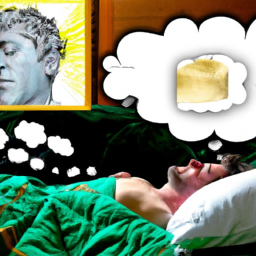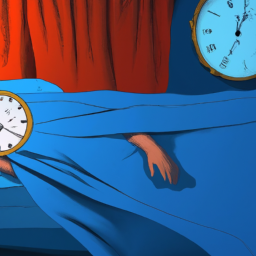I recently stopped using marijuana and observed a notable enhancement in the clarity of my dreams. Initially, the prospect of encountering such intricate and lifelike dream environments thrilled me. Yet, as my dreams grew more vivid and occurred more often, it led me to question the reasons behind this change and whether it was a common experience.
After some research, I discovered that this phenomenon is a common side effect of quitting marijuana. In this article, I will explore the reasons behind this rebound effect and what it means for those who have recently stopped using marijuana.
Additionally, I will discuss some potential benefits and drawbacks of vivid dreams, as well as coping strategies for managing these intense dream experiences. So, if you’re like me and wondering why your dreams have become so vivid after quitting weed, keep reading to find out more.
Key Takeaways
- Quitting marijuana can lead to an increase in vivid and intense dreams due to the rebound effect.
- Vivid dreams after quitting marijuana can have potential benefits, such as self-reflection and reinforcement of sobriety, but can also have drawbacks such as increased frequency of nightmares and heightened anxiety levels.
- Coping strategies for managing vivid dreams after quitting marijuana include establishing a relaxing bedtime routine, avoiding stimulants before bedtime, and practicing mindfulness and relaxation techniques.
- Understanding individual variations in dream experiences and prioritizing sleep hygiene is crucial for effectively managing dream experiences after quitting marijuana.
Understanding the Effects of Marijuana on the Brain
Smoking weed messes with your brain, making your dreams feel like a trippy movie playing in your mind.
Marijuana contains compounds that affect the brain’s ability to regulate sleep and dream cycles. THC, the main psychoactive ingredient in marijuana, disrupts the brain’s REM (Rapid Eye Movement) sleep, which is when we experience the most vivid and intense dreams.
When you smoke weed, you may not remember your dreams as well because THC suppresses your ability to dream, but as soon as you stop smoking, your brain experiences a rebound effect. The rebound effect is when your brain tries to catch up on all the REM sleep and dream cycles it missed while you were smoking weed.
As a result, your dreams become more vivid, intense, and memorable. This is because your brain is trying to make up for lost time. Your dreams may also become more vivid because your brain is trying to process and make sense of all the new information and experiences you have been exposed to while you were high.
So don’t be surprised if you start having wild and crazy dreams after quitting weed!
The Rebound Effect
You’re experiencing a rush of intense mental activity, like a sudden influx of bright colors and sounds, as your brain adjusts to the absence of THC. This phenomenon is known as the rebound effect, and it’s a common experience for people who have recently quit using marijuana.
Essentially, your brain is working overtime to compensate for the lack of stimulation it was receiving from THC, which can cause a range of symptoms including vivid dreams, heightened anxiety, and difficulty sleeping.
One of the most noticeable effects of the rebound effect is the vivid dreams that many people experience after quitting marijuana. These dreams can be incredibly realistic and intense, often featuring vivid colors, sounds, and emotions. Some people even report having lucid dreams, where they are aware that they are dreaming and can control the dream’s outcome.
While these dreams can be unsettling or even disturbing, they are a normal part of the recovery process and will typically fade over time as your brain readjusts to its normal functioning.
Common Dream Experiences After Quitting Marijuana
Experiencing intense and realistic dreams is a common occurrence for those who’ve recently quit using marijuana. After years of smoking weed, my dreams had become dull and unmemorable. But when I decided to quit, I wasn’t prepared for the vivid and sometimes unsettling dreams that followed.
Here are some common dream experiences I had after quitting marijuana:
- Lucid dreams where I was aware I was dreaming
- Dreams about relapsing and using marijuana again
- Nightmares about past traumas or anxieties
- Dreams that were so realistic, I woke up feeling like they had actually happened
Although these dreams were sometimes disturbing, I found them to be a necessary part of my recovery process. They forced me to confront my fears and anxieties, and helped me to process unresolved emotions. As I learned to navigate the intense dream world, I began to see the potential benefits of vivid dreams after quitting marijuana.
Potential Benefits of Vivid Dreams After Quitting Marijuana
As you adjust to a life without marijuana, your mind may open up to a world of vivid dreams that offer a unique opportunity for self-reflection and growth.
These dreams can be intense and memorable, allowing you to explore your subconscious thoughts and emotions in a way that you may not have been able to while using marijuana.
The increased clarity and detail in your dreams can also serve as a reminder of the benefits of sobriety, helping to reinforce your commitment to a healthier lifestyle.
While the intensity of these dreams may be initially overwhelming, it’s important to recognize their potential benefits.
By engaging with your dreams and exploring their meaning, you may gain valuable insights into your own psyche, allowing you to better understand yourself and your motivations.
However, it’s also important to be aware of the potential drawbacks of vivid dreams after quitting marijuana, which we will explore further in the next section.
Drawbacks of Vivid Dreams After Quitting Marijuana
The increased frequency of nightmares is a common side effect of quitting marijuana, affecting up to 40% of individuals according to a study published in the Journal of Clinical Sleep Medicine. Personally, I’ve experienced this firsthand. My dreams have become incredibly vivid since I stopped smoking weed.
While some of them are pleasant, others are downright terrifying. It’s like my brain is processing all the suppressed emotions and thoughts that I used to numb with weed.
It’s been tough to deal with these vivid dreams, especially since they’ve been affecting my sleep quality. I wake up feeling exhausted, and it’s hard to shake off the negative emotions that linger from the nightmares. On top of that, I’ve noticed that my anxiety levels have gone up since quitting weed, which only exacerbates the problem.
It’s been a difficult adjustment, but I know that it’s a necessary one for my overall health and well-being. In the next section, I’ll share some coping strategies that have worked for me in managing these vivid dreams.
Coping Strategies for Managing Vivid Dreams After Quitting Marijuana
Are you struggling to manage the intense dreams that come with quitting marijuana? Here are some coping strategies that may help you get a better night’s sleep and feel more at ease during the day.
First, try to establish a relaxing bedtime routine that will help you wind down before going to sleep. This may include taking a warm bath, reading a book, or listening to calming music. Additionally, avoid consuming caffeine or other stimulants before bedtime, as they can exacerbate the vividness of your dreams.
Another helpful strategy is to practice mindfulness and relaxation techniques throughout the day. This can include meditation, deep breathing exercises, or yoga. By reducing stress and promoting relaxation, you may find that your dreams become less intense and more manageable.
These coping strategies can be effective in reducing the impact of vivid dreams after quitting marijuana. Incorporating lucid dreaming techniques can also be helpful in gaining control over your dreams.
Incorporating Lucid Dreaming Techniques
I’ve been struggling with vivid dreams ever since I stopped smoking weed, and it’s been a real challenge for me. I’ve tried various coping strategies, from meditation to reading before bed, but nothing seems to work consistently.
That’s when I discovered lucid dreaming techniques, and it’s been a game-changer for me. Lucid dreaming is the practice of becoming aware that you’re dreaming and being able to control the dream. By incorporating techniques like reality checks and setting intentions before bed, I’ve been able to not only reduce the intensity of my vivid dreams but also turn them into enjoyable and even empowering experiences.
It takes some practice and dedication, but it’s definitely been worth it for me. Now, to understand individual variations in dream experiences, it’s important to recognize that everyone’s brain chemistry and life experiences are different. While some people may have no trouble sleeping or dreaming after quitting marijuana, others like me may experience intense and vivid dreams.
It’s important to find what works best for you and to not compare your experience to others’. With that in mind, let’s take a closer look at how to understand and manage individual variations in dream experiences.
Understanding Individual Variations in Dream Experiences
Understanding individual variations in dream experiences can be crucial in finding effective coping strategies for those who struggle with intense and vivid dreams after quitting marijuana. While some individuals may experience dreams that are unsettling or anxiety-provoking, others may have dreams that are more neutral or even pleasant. Additionally, past experiences and traumas may affect the content and intensity of dreams. For example, a person who experienced a traumatic event in their past may have dreams that are more intense or disturbing than someone who did not.
To better understand individual variations in dream experiences, it can be helpful to examine the different factors that contribute to dream content and intensity. The table below outlines some of these factors, including past experiences, personality traits, and environmental factors. By identifying these factors and their potential impact on dream experiences, individuals can work towards developing personalized strategies for managing their dreams and promoting restful sleep.
Transitioning into the subsequent section, it is important to note that understanding individual variations in dream experiences is just one aspect of managing intense and vivid dreams after quitting marijuana. Another important factor to consider is the role of sleep hygiene in promoting restful sleep and reducing the likelihood of intense dreams.
The Role of Sleep Hygiene in Managing Dream Experiences
To effectively manage your dream experiences after quitting marijuana, it’s crucial to prioritize good sleep hygiene practices that promote restful and peaceful sleep.
This means creating a sleep-conducive environment by keeping the bedroom dark, quiet, and cool. It also involves establishing a consistent sleep schedule, avoiding stimulating activities or substances before bedtime, and engaging in relaxation techniques such as deep breathing or meditation.
Additionally, it’s important to practice good sleep hygiene throughout the day by avoiding naps, limiting caffeine intake, and getting regular exercise. These habits can help regulate your body’s natural sleep-wake cycle and ensure that you’re tired at night.
By prioritizing sleep hygiene, you can reduce the likelihood of experiencing vivid or disturbing dreams and wake up feeling refreshed and ready for the day ahead.
Frequently Asked Questions
How long do vivid dreams last after quitting weed?
I can’t say for sure how long vivid dreams last after quitting weed. It varies from person to person. But for me, it took a few weeks before my dreams returned to normal.
Can vivid dreams after quitting weed be dangerous?
No, vivid dreams after quitting weed are not dangerous. They are a normal part of the brain’s adjustment process. They may be unsettling, but they will eventually decrease in intensity and frequency.
Is it normal to experience nightmares after quitting weed?
Yes, it’s common to experience nightmares after quitting weed. It’s due to the REM rebound effect, where the brain attempts to catch up on lost REM sleep. The vivid dreams should subside within a few weeks.
Can vivid dreams after quitting weed be a sign of underlying mental health issues?
I’ve experienced vivid dreams after quitting weed, but it doesn’t necessarily indicate underlying mental health issues. It’s a common side effect of withdrawal, and can be a sign of your brain adjusting to the absence of THC.
Will the intensity of vivid dreams after quitting weed decrease over time?
I’ve noticed that the intensity of my vivid dreams after quitting weed has decreased over time. It was overwhelming at first, but now my dreams are becoming less intense and more manageable.
Conclusion
Overall, quitting marijuana can lead to vivid and intense dreams due to the rebound effect on the brain. While some may view this as a positive experience, others may find it overwhelming and disruptive to their sleep.
Coping strategies such as incorporating lucid dreaming techniques and practicing good sleep hygiene can help manage these experiences. In the end, the decision to quit smoking weed is a personal one, and the potential effects on dream experiences should be taken into consideration.
Whether the vivid dreams are a positive or negative experience, it’s important to remember that they’re a normal part of the brain’s rebound process and will eventually subside. As with any major lifestyle change, it’s important to seek support and guidance from trusted sources to ensure a successful transition.









